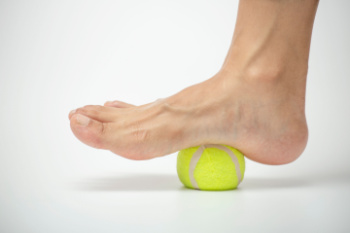 Foot pain is a significant factor contributing to falls in seniors. Research indicates a link between severe foot pain and a higher incidence of recurrent falls in older adults. Conditions like arthritis, plantar fasciitis, bunions, and flat feet can cause pain that affects balance and gait. Flat feet, in particular, can lead to altered foot mechanics, increasing the risk of falling. A podiatrist can be instrumental in preventing falls by addressing these issues through regular foot examinations. This foot doctor can diagnose and treat foot conditions, as well as recommend supportive footwear and prescribe orthotic inserts. They can also provide pain management strategies and suggest personalized strength training and foot exercise programs that improve stability and mobility. If you are 65 years of age or older and have fallen in the last year as a result of foot pain, it is suggested that you schedule an appointment with a podiatrist for an exam and suggested fall prevention measures.
Foot pain is a significant factor contributing to falls in seniors. Research indicates a link between severe foot pain and a higher incidence of recurrent falls in older adults. Conditions like arthritis, plantar fasciitis, bunions, and flat feet can cause pain that affects balance and gait. Flat feet, in particular, can lead to altered foot mechanics, increasing the risk of falling. A podiatrist can be instrumental in preventing falls by addressing these issues through regular foot examinations. This foot doctor can diagnose and treat foot conditions, as well as recommend supportive footwear and prescribe orthotic inserts. They can also provide pain management strategies and suggest personalized strength training and foot exercise programs that improve stability and mobility. If you are 65 years of age or older and have fallen in the last year as a result of foot pain, it is suggested that you schedule an appointment with a podiatrist for an exam and suggested fall prevention measures.
Preventing falls among the elderly is very important. If you are older and have fallen or fear that you are prone to falling, consult with Darren Day, DPM from Hawaii. Our doctor will assess your condition and provide you with quality advice and care.
Every 11 seconds, an elderly American is being treated in an emergency room for a fall related injury. Falls are the leading cause of head and hip injuries for those 65 and older. Due to decreases in strength, balance, senses, and lack of awareness, elderly persons are very susceptible to falling. Thankfully, there are a number of things older persons can do to prevent falls.
How to Prevent Falls
Some effective methods that older persons can do to prevent falls include:
- Enrolling in strength and balance exercise program to increase balance and strength
- Periodically having your sight and hearing checked
- Discuss any medications you have with a doctor to see if it increases the risk of falling
- Clearing the house of falling hazards and installing devices like grab bars and railings
- Utilizing a walker or cane
- Wearing shoes that provide good support and cushioning
- Talking to family members about falling and increasing awareness
Falling can be a traumatic and embarrassing experience for elderly persons; this can make them less willing to leave the house, and less willing to talk to someone about their fears of falling. Doing such things, however, will increase the likelihood of tripping or losing one’s balance. Knowing the causes of falling and how to prevent them is the best way to mitigate the risk of serious injury.
If you have any questions, please feel free to contact our offices located in Honolulu and Kahuku, HI . We offer the newest diagnostic and treatment technologies for all your foot care needs.

Exercising your feet offers numerous benefits that can enhance your overall foot health, reduce pain, and keep you active. Gentle stretches and strength exercises improve flexibility and strengthen the muscles that support your feet, which can help prevent injuries and alleviate discomfort. For example, toe raise, point, and curl exercises can get your toes and feet moving, while toe splay movements help gain control over your toe muscles. Toe extensions are particularly beneficial for preventing or treating plantar fasciitis. Additionally, activities like toe curls, marble pickups, and big toe stretches strengthen various muscles in your feet and improve their range of motion. Rolling a tennis ball under your foot can also provide relief from arch pain and plantar fasciitis. Finally, Achilles tendon stretches help maintain flexibility while preventing foot, ankle, and leg pain. You can perform these foot exercises three days a week or even daily for lifelong foot health. If you have any injuries, arthritis, diabetes, or persistent foot and ankle pain, consult a foot doctor before starting any new exercise routine. It is suggested that you schedule an appointment with a podiatrist for an exam and expert treatment.
Exercising your feet regularly with the proper foot wear is a great way to prevent injuries and build strength. If you have any concerns about your feet, contact Darren Day, DPM from Hawaii. Our doctor can provide the care you need to keep you pain-free and on your feet.
Exercise for Your Feet
Exercise for your feet can help you gain strength, mobility and flexibility in your feet. They say that strengthening your feet can be just as rewarding as strengthening another part of the body. Your feet are very important, and we often forget about them in our daily tasks. But it is because of our feet that are we able to get going and do what we need to. For those of us fortunate enough to not have any foot problems, it is an important gesture to take care of them to ensure good health in the long run.
Some foot health exercises can include ankle pumps, tip-toeing, toe rises, lifting off the floor doing reps and sets, and flexing the toes. It is best to speak with Our doctor to determine an appropriate regimen for your needs. Everyone’s needs and bodies are different, and the activities required to maintain strength in the feet vary from individual to individual.
Once you get into a routine of doing regular exercise, you may notice a difference in your feet and how strong they may become.
If you have any questions please feel free to contact our offices located in Honolulu and Kahuku, HI . We offer the newest diagnostic and treatment technologies for all your foot and ankle needs.
 Plantar fasciitis is a common foot condition in golfers due to the prolonged periods of standing and walking involved in the game. Regular foot stretches can help prevent this painful condition. Before hitting the golf course, it is beneficial to perform calf stretches by leaning against a wall with one foot forward and the other extended back. Stretching the arch of the foot by rolling a golf ball under it can also be effective. Additionally, toe stretches, where you pull your toes back towards your shin, help maintain flexibility in the plantar fascia. Incorporating these stretches into your routine not only reduces the risk of plantar fasciitis but also enhances overall foot comfort and performance on the course. Consistent stretching ensures that your feet are well-prepared for the demands of a round of golf. It is also helpful to wear shoes that have adequate arch support or to add orthotics to existing shoes, if needed. If you have developed heel pain while playing golf, it is suggested that you visit a podiatrist who can diagnose and treat plantar fasciitis.
Plantar fasciitis is a common foot condition in golfers due to the prolonged periods of standing and walking involved in the game. Regular foot stretches can help prevent this painful condition. Before hitting the golf course, it is beneficial to perform calf stretches by leaning against a wall with one foot forward and the other extended back. Stretching the arch of the foot by rolling a golf ball under it can also be effective. Additionally, toe stretches, where you pull your toes back towards your shin, help maintain flexibility in the plantar fascia. Incorporating these stretches into your routine not only reduces the risk of plantar fasciitis but also enhances overall foot comfort and performance on the course. Consistent stretching ensures that your feet are well-prepared for the demands of a round of golf. It is also helpful to wear shoes that have adequate arch support or to add orthotics to existing shoes, if needed. If you have developed heel pain while playing golf, it is suggested that you visit a podiatrist who can diagnose and treat plantar fasciitis.
Sports related foot and ankle injuries require proper treatment before players can go back to their regular routines. For more information, contact Darren Day, DPM of Hawaii. Our doctor can provide the care you need to keep you pain-free and on your feet.
Sports Related Foot and Ankle Injuries
Foot and ankle injuries are a common occurrence when it comes to athletes of any sport. While many athletes dismiss the initial aches and pains, the truth is that ignoring potential foot and ankle injuries can lead to serious problems. As athletes continue to place pressure and strain the area further, a mild injury can turn into something as serious as a rupture and may lead to a permanent disability. There are many factors that contribute to sports related foot and ankle injuries, which include failure to warm up properly, not providing support or wearing bad footwear. Common injuries and conditions athletes face, including:
- Plantar Fasciitis
- Plantar Fasciosis
- Achilles Tendinitis
- Achilles Tendon Rupture
- Ankle Sprains
Sports related injuries are commonly treated using the RICE method. This includes rest, applying ice to the injured area, compression and elevating the ankle. More serious sprains and injuries may require surgery, which could include arthroscopic and reconstructive surgery. Rehabilitation and therapy may also be required in order to get any recovering athlete to become fully functional again. Any unusual aches and pains an athlete sustains must be evaluated by a licensed, reputable medical professional.
If you have any questions please feel free to contact our offices located in Honolulu and Kahuku, HI . We offer the newest diagnostic and treatment technologies for all your foot and ankle needs.






